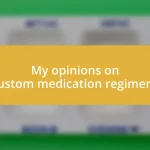Key takeaways:
- Risk assessment tools provide structured frameworks that transform abstract fears into manageable tasks, aiding in informed decision-making and team preparedness.
- Choosing the right tool is crucial and should consider project-specific needs, team dynamics, and integration with existing workflows to become an effective part of the process.
- Continuous improvement in risk management practices fosters open communication, collective learning, and emotional engagement within teams, enhancing overall risk assessment outcomes.

Understanding risk assessment tools
Risk assessment tools serve as essential frameworks for identifying and evaluating potential hazards in various settings. I still remember my first experience using a risk assessment matrix during a project; the clarity it provided was a game changer. By systematically categorizing risks, I could focus my efforts where they mattered most, ensuring that my team understood which areas needed immediate attention.
These tools can seem daunting at first, especially for someone new to the concept, but they ultimately simplify complex scenarios. Have you ever felt overwhelmed by countless possible risks? I certainly have. Once I embraced the structured approach of a risk assessment tool, I found that my anxiety lessened. It turned abstract fears into manageable tasks, allowing me to move forward confidently.
Moreover, understanding the language of risk assessment tools—like terms such as “likelihood,” “impact,” and “mitigation”—is key to leveraging them effectively. As I delved deeper into these concepts, I began to see patterns that I hadn’t noticed before. It’s fascinating to realize how recognizing these patterns not only helps in decision-making but influences a team’s overall preparedness.

Importance of risk assessment
Understanding the importance of risk assessment is pivotal; it can be that light bulb moment in any project. I recall one time when a team overlooked a minor risk that ended up spiraling out of control. That experience underscored for me that proactive risk assessment not only identifies potential issues but also empowers teams to make informed decisions, fostering a culture of safety and preparedness.
Here are some key reasons why risk assessment is crucial:
- Prevention of Financial Loss: Identifying risks early can save significant costs associated with unexpected issues.
- Improved Safety Measures: It facilitates the development of effective safety practices that protect employees and clients alike.
- Enhanced Reputation: A proactive stance on risk showcases reliability, which can attract clients and partners.
- Better Compliance: It ensures adherence to regulations, reducing the chances of legal troubles.
- Informed Decision-Making: By clearly understanding risks, teams can prioritize actions, ensuring resources are allocated efficiently.

Types of risk assessment tools
When exploring risk assessment tools, I’ve encountered several types that cater to different needs and contexts. The Qualitative Risk Assessment tools, for instance, focus on descriptive measures to evaluate risks based on subjective judgment. I distinctly remember using a qualitative matrix during a workshop; the discussions it spurred helped uncover risks that our team hadn’t even considered! On the other hand, Quantitative Risk Assessment tools provide numerical data to evaluate the likelihood and impact of risks, helping in scenarios where hard data can be gathered. I once employed a quantitative analysis for a project, and the insights were incredibly valuable for budget forecasting.
Another notable category is Semi-Quantitative Risk Assessment, which combines elements of both qualitative and quantitative approaches. This hybrid methodology allows for a broader view of risks while still retaining some numerical grounding. I once faced a project where our risks were too complex for a purely quantitative approach, and using semi-quantitative assessments helped us achieve a balanced view, considering both data and team insights.
Lastly, Software-Based Risk Assessment Tools have been a game changer in streamlining the risk evaluation process. When I first tried using a specialized software tool, I was struck by how efficiently it gathered and processed risk data, making it accessible for the whole team. It’s remarkable how technology can simplify what once felt overwhelming, turning a once-laborious task into a seamless experience.
| Type of Tool | Description |
|---|---|
| Qualitative Risk Assessment | Descriptive measures based on subjective judgment. |
| Quantitative Risk Assessment | Numerical data for evaluating risks based on likelihood and impact. |
| Semi-Quantitative Risk Assessment | Combines qualitative and quantitative methods for a balanced view. |
| Software-Based Risk Assessment | Utilizes technology to streamline risk evaluation processes. |

Choosing the right tool
Choosing the right tool for risk assessment is often a balance of necessity and preference. Personally, I’ve navigated this landscape by considering the specific requirements of each project. For instance, during a critical project, I opted for a qualitative tool because the team had varying levels of expertise, and I knew we’d benefit from discussions to highlight hidden risks. Sometimes, the best insights come not just from numbers but from our collective experiences.
I remember a time when I hesitated between a quantitative and semi-quantitative tool, each promising valuable insights. Ultimately, I chose the semi-quantitative approach because it offered a blend of data and personal input. That decision transformed our risk analysis session into a dynamic exchange. Have you ever felt the tension between wanting precise data and recognizing the importance of team input? It’s a pivotal moment that can shape the entire assessment.
Another factor to consider is how well a tool integrates with existing workflows. In my experience, the smoother the integration, the more effective the risk assessment becomes. I used to grapple with tools that felt detached from our everyday tasks, leading to frustration. However, when I switched to a software-based tool that seamlessly aligned with our processes, it was like a breath of fresh air. It made everyone more engaged, turning what once felt like a chore into an opportunity for collaboration. Isn’t it amazing how the right tool can turn a daunting task into a fluid team effort?

Implementing risk assessment tools
Implementing risk assessment tools can sometimes feel like navigating a complex maze. I remember when our team decided to adopt a new software-based risk assessment tool. The implementation process was eye-opening; we encountered both excitement and skepticism. Some team members were hesitant about using technology, but as we started to see how intuitive and user-friendly it was, their resistance faded away. Have you ever faced that initial pushback when introducing new processes? It’s incredibly rewarding to witness a shift from doubt to acceptance as the tool begins to make our work easier.
As we rolled out the tool, I discovered the importance of training and communication in the implementation phase. I organized informal training sessions, where we could explore features together and share questions. It was fascinating to see the camaraderie grow as we tackled challenges as a unit. I vividly recall when one team member had a breakthrough moment in understanding how to visualize risk data, leading to a discussion that unlocked several hidden risks in our project. Those moments of collective enlightenment kept reinforcing our teamwork, transforming the tool from just software into a vital part of our culture.
However, I quickly learned that simply having a tool isn’t enough; it’s about fostering a mindset focused on proactive risk management. Initially, our team viewed risk assessments as a checkbox activity, but I encouraged everyone to approach it as an ongoing conversation. By regularly revisiting the tool and updating our assessments, we cultivated a richer understanding of the evolving risks in our projects. It’s funny how a shift in perspective can turn a mundane task into an engaging dialogue. Have you noticed this in your own experiences with risk management? It’s these small yet powerful shifts that truly make a difference in risk assessment implementation.

Analyzing results from assessments
When it comes to analyzing results from assessments, I’ve found that the real insight often lies in the conversations following the data review. After finishing an evaluation, I remember gathering the team to discuss our findings. It was fascinating to see how different perspectives brought new interpretations to the same set of numbers. Have you ever noticed how a single piece of data can spark a rich debate among colleagues? The exchange of ideas can unveil underlying issues that may have initially gone unnoticed.
One standout experience was when I conducted a risk assessment that revealed a surprisingly high likelihood of project delays. While the data was clear, it was the team’s discussion that truly illuminated the root causes behind the numbers. As we talked through the implications, I could feel the tension in the room; we were facing a critical moment. Those candid exchanges not only fostered a sense of ownership but led us to actionable strategies that we might not have considered otherwise. It’s moments like these that remind me how vital it is to approach results with an open mind.
I’ve also learned to embrace visualization tools as part of the results analysis process. Creating graphs or charts has transformed the way I present data. For instance, during one project, I opted to use a simple color-coded chart to illustrate risk levels. This simple change breathed life into our findings, making it easier for everyone to grasp the key issues at a glance. Isn’t it incredible how a visual can make complex data more accessible? I often find that when people can visually connect with the data, their buy-in increases significantly, sparking a deeper commitment to mitigating those risks together.

Continuous improvement in risk assessment
Continuous improvement in risk assessment is something I’ve actively embraced throughout my projects. One memorable experience was when our team held a retrospective after several months of using our new risk assessment tool. As we reflected on our progress, we identified not just the technical improvements, but also the increased confidence we had in discussing risks openly. Have you ever felt that sense of growth just by revisiting your processes?
I also strongly believe in incorporating feedback loops into our risk management strategies. After a particularly intensive project, I started a habit of regularly soliciting input from my team on the tool’s effectiveness. One suggestion led me to implement a ‘lessons learned’ section in our assessments where we could document key takeaways. This not only enhanced our future risk evaluations but also fostered a culture of continuous learning. How often do you think we actually take the time to reflect and adapt?
Ultimately, I’ve realized that continuous improvement is not just about refining tools; it’s about cultivating an environment where risk assessment becomes a shared responsibility. In one project, I initiated monthly check-ins where we discussed not only the current risks but also explored our emotional responses to those risks. This simple act of sharing feelings about potential pitfalls allowed us to bond and attack challenges with a renewed sense of unity. Isn’t it amazing how vulnerability can lead to stronger teamwork in risk management?














